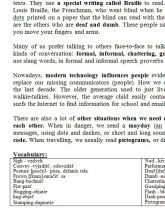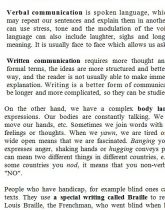Maturitné otázky: Communication and Its Forms
Skryť detaily | Obľúbený- Kvalita:73,9 %
- Typ:Maturitné otázky
- Univerzita:Vysoká škola zdravotníctva a sociálnej práce sv. Alžbety
- Kategória:Jazyky
- Podkategória:Angličtina
- Predmet:Anglický jazyk
- Autor:bibuska
- Ročník:1. ročník
- Rozsah A4:1 strán
- Zobrazené:3 892 x
- Stiahnuté:196 x
- Veľkosť:0,1 MB
- Formát a prípona:MS Office Word (.doc)
- Jazyk:anglický
- ID projektu:11673
- Posledna úprava:18.12.2018
Verbal communication is spoken language, which is often spontaneous. If necessary, we may repeat our sentences and explain them in another simpler way. In verbal communication we can use stress, tone and the modulation of the voice to express different meanings. Spoken language can also include laughter, sighs and long expressive pauses to produce additional meaning. It is usually face to face which allows us ask questions and get immediate answers.
Written communication requires more thought and planning, and is often expressed more formal terms, the ideas are more structured and better organised. Written communication is one-way, and the reader is not usually able to make immediate reference to the writer to ask for more explanation. Writing is a better form of communication for recording facts and ideas. Texts can be longer and more complicated, so they can be studied later.
On the other hand, we have a complex body language of gestures, postures, and facial expressions. Our bodies are constantly talking. We smile, frown or make different gestures, move our hands, etc. Sometimes we join words with gestures, other times our bodies show our feelings or thoughts. When we yawn, we are tired or bored. Sitting with our mouth and eyes wide open means that we are fascinated. Banging your fist on the table or stamping your feet expresses anger, shaking hands or hugging conveys pleasure or satisfaction. But one movement can mean two different things in different countries, e.g. if you move your head up and down, in some countries you nod, it means that you non-verbally say "Yes", but in Bulgaria it means "NO".
Written communication requires more thought and planning, and is often expressed more formal terms, the ideas are more structured and better organised. Written communication is one-way, and the reader is not usually able to make immediate reference to the writer to ask for more explanation. Writing is a better form of communication for recording facts and ideas. Texts can be longer and more complicated, so they can be studied later.
On the other hand, we have a complex body language of gestures, postures, and facial expressions. Our bodies are constantly talking. We smile, frown or make different gestures, move our hands, etc. Sometimes we join words with gestures, other times our bodies show our feelings or thoughts. When we yawn, we are tired or bored. Sitting with our mouth and eyes wide open means that we are fascinated. Banging your fist on the table or stamping your feet expresses anger, shaking hands or hugging conveys pleasure or satisfaction. But one movement can mean two different things in different countries, e.g. if you move your head up and down, in some countries you nod, it means that you non-verbally say "Yes", but in Bulgaria it means "NO".


